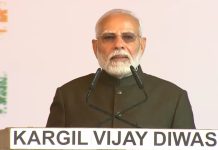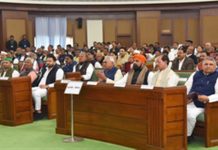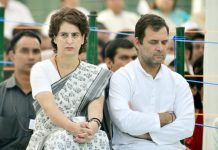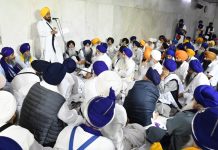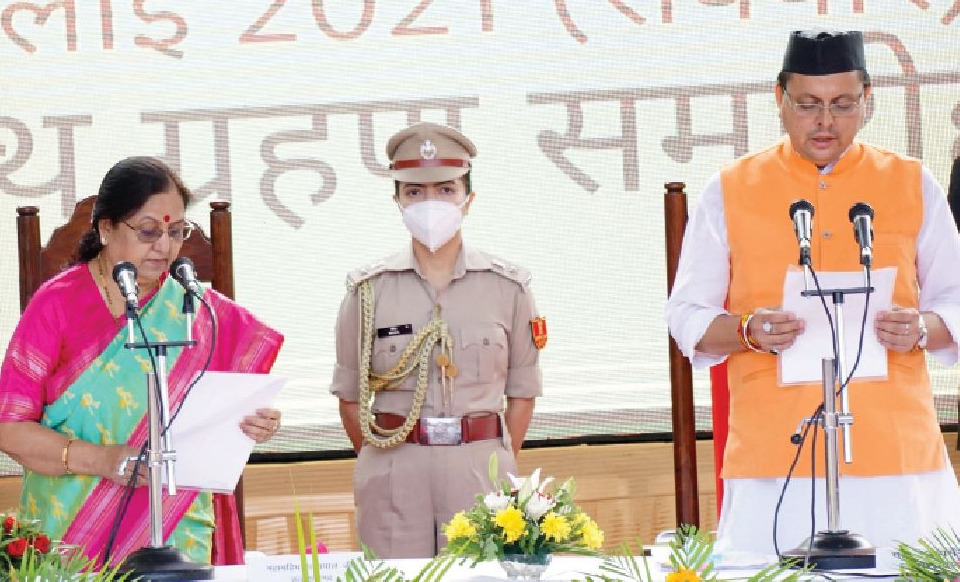
Political instability stalks Uttarakhand, writes RAJ KANWAR
Political instability today stalks Uttarakhand thanks to the frequent changes of its chief ministers. The state that was born on 9th November 2000 has had 12 chief ministers in its short lifespan of just 21 years — a new chief minister almost every second year. Of them Gen Khanduri and Harish Rawat have had two terms each.
Anoop Nautiyal, veteran social activist and founder of Dehra Dun-based SDC Foundation, strongly feels that “the worst sufferers of this political drama being staged in the state are its people whose aspirations remain unfulfilled.”
Political one-upmanship is the name of the game. Nityanand Swami was sworn in as the first chief minister of the new state of Uttarakhand on 9th November 2000. A few parochial elements in BJP including Bhagat Singh Koshiyari, currently the Maharashtra Governor, and other vested interests in the State did not want a ‘gentleman chief minister’, and launched an invidious whispering campaign against Swami, calling him an ‘outsider’.
Pray! How could an individual who had lived all of his life in Dehra Dun, and had represented Kumaon-Garhwal Graduates constituency in the Vidhan Parishad for three consecutive terms could be an ‘outsider’? Perhaps, Swami did not have the ‘right’ surname.
Despite several unique achievements and a transparent mode of governance, the mischievous elements succeeded in their vicious attacks, and Swami was compelled to step down even before he could complete one year in office (11 months and 20 days to be exact).
With the General Elections just a few months away, Bhagat Singh Koshiyari was installed as Swami’s successor. BJP fared badly in the elections that followed paving way for the victory of the Congress, and the installation of ND Tiwari as the Chief Minister. It was simply a case of cutting one’s own nose to spite one’s face.
BJP’s turn
BJP, however, turned the tables in the subsequent elections held in March 2007 and returned to Power. Owing to the intense infighting in the party, a dark horse in Maj Gen Bhuwan Chandra Khanduri was installed as the chief minister. But the internal differences remained unabated, and the General had had to abdicate his office midway. That paved the way for a former Hindi journalist Ramesh Pokhriyal Nishank to become the state’s fifth chief minister. He remained in office for two years and 75 days, but had had to step down owing to the charges of maladministration within his government, and the growing corruption among the state officials. Coincidentally, it was Gen Khanduri again whom Nishank had relieved earlier took over from him. How very bizarre? The General replaced Nishank because of the charges of maladministration against his government, and then Nishank again replaced the General. All that was nothing but political jugglery!
Veteran journalist SMA Kazmi laments that “the state of Uttarakhand started with political uncertainty since its very inception when Bhagat Singh Koshiyari and Ramesh Pokhriyal Nishank refused to be part of Nityanand Swami Government. Overambitious political leaders, who are not even qualified to become Panchayat members, are ruling the roost, and have plunged the state into political turmoil during the past two decades.”
Congress rule
In the ensuing general election held on 30 January 2012, the Congress emerged as the largest single party with 32 seats in a House of 70. BJP came a close second with 31 members. However, it was the Congress that succeeded in forming the government with the help of the Progressive Democratic Front (comprising Bahujan Samaj Party, Uttarakhand Kranti Dal and a handful of independents). Vijay Bahuguna, a lawyer-turned-judge, a former BJP MP from Tehri Garhwal and a political turncoat who was not even an MLA, was air dropped in Dehra Dun as the Uttarakhand’s seventh chief minister. The choice of the Bahuguna as its chief minister by the Congress, to say the least, was the most opportunistic and amoral. Bahuguna had had to resign in July 2014 following the widespread criticism of his mishandling the rehabilitation of the thousands of people displaced in the wake of the June 2013 floods.
Following Bahuguna’s resignation, Harish Rawat became the eighth chief minister in February 2014. He too like Bahuguna was a non-legislator, and was subsequently elected to the Assembly from Dharchula. Rawat’s tenure too became controversial following the rebellion of nine Congress MLAs that reduced the government into minority. The BJP government in Delhi seized that opportunity and promptly imposed the President’s Rule in the state on 22 April 2016. Fortuitously, Rawat later won the vote of confidence and was reinstated on 11 May 2016 as the Chief Minister. The 46-days long President’s Rule was perhaps the shortest in India’s constitutional history. However, in the General Elections that followed in 2017, the BJP won hands down. And Trivendra Singh Rawat became the state’s 10th
Chief Minister! TS Rawat told to quit
But this game of Musical Chairs turned into a tragicomedy when Trivendra Singh Rawat was suddenly asked to resign for some of his acts of commission and omission. Additionally, there was also a growing dissatisfaction against him among the MLAs. Here, it needs to be added that politicians once elected as legislators are not content just being MLAs; they invariably want some sort of semblance of power with perks and Lal Battis. The Chief Minister was then considering appointing a few MLAs as chairmen of State Corporations when the axe fell on him. And that ended his controversial term lasting nearly four years.
What followed was even more whimsical. Instead of choosing one of the many senior leaders from among Satpal Maharaj, Yaspal Arya, Harak Singh Rawat, Bishan Singh Chufal et al, or any other MLA, the choice of the BJP High Command fell on a member of the Lok Sabha from Garhwal, Tirath Singh Rawat — an unknown name in the corridors of power in Dehra Dun. Why the BJP leadership chose a member of the Lok Sabha rather than of the Vidhan Sabha will ever remain a mystery? Being a non-legislator, the new chief minister was required to get elected to the Vidhan Sabha within six months. No thought was given to that issue for four months; and then with no time left to get elected to the Vidhan Sabha within the stipulated period of six months, the BJP leadership had no choice but to ask Tirath Singh to resign as the chief minister.
Surprise after surprise
Like misfortunes, one surprise too follows another. Having burnt its fingers once in its earlier choice of a Member of Parliament, the BJP leadership caused another surprise by selecting a virtual non-entity in Pushkar Singh Dhami, the young and highly educated two-time MLA from Khatima in Udham Singh Nagar. He is barely 45 years of age and still a greenhorn in politics. There was an obvious chorus of discontent and disappointment among most of the MLAs; some of them too were aspirants for the CM’s chair. In a Ministry, a Chief Minister is supposed to be the first among the equals. However, in the instant scenario, Dhami is the youngest among the ministers. How will he wield his baton to oversee the functioning of the ministry and the performance of the ministers at large raises a big question mark?
Raj Kanwar is a Dehra Dun-based journalist, writer and author. Views are personal.
tehelkaletters@gmail.com


